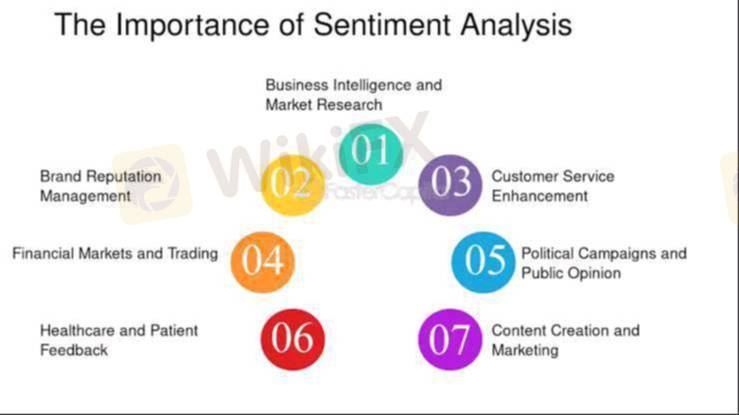
2025-02-17 22:01
IndustriaThe role of sentiment analysis in risk mitigation.
#forexrisktip
Sentiment analysis plays a crucial role in risk mitigation by allowing organizations to understand and respond to public sentiment about their brand, products, or services. Here's how it works:
1. Identifying Potential Risks:
* Early Warning System: By monitoring social media, news articles, and other online platforms, sentiment analysis tools can detect emerging negative trends or opinions that could escalate into a crisis.
* Cybersecurity Threats: Sentiment analysis can be used to identify potential cyber threats by analyzing emotional tones in online discussions, social media, and communications. This can help organizations detect and prevent cyberattacks.
* Brand Reputation: Sentiment analysis can help organizations understand how their brand is perceived by the public. This information can be used to mitigate risks to brand reputation.
2. Proactive Mitigation:
* Address Issues Promptly: Once a potential risk is identified, organizations can take proactive steps to address the issue before it escalates. This might involve responding to negative feedback, issuing a public statement, or taking corrective action.
* Improve Customer Experience: By understanding customer sentiment, organizations can identify areas where they can improve the customer experience and reduce the risk of negative feedback.
3. Crisis Management:
* Monitor Public Reaction: During a crisis, sentiment analysis can be used to monitor public reaction and understand how the situation is being perceived. This information can be used to inform crisis communication strategies.
* Measure the Effectiveness of Responses: Sentiment analysis can be used to measure the effectiveness of crisis response strategies and make adjustments as needed.
Examples of Sentiment Analysis in Risk Mitigation:
* A company detects a spike in negative sentiment on social media about a new product. They investigate the issue and find that customers are unhappy with a specific feature. The company can then take steps to address the issue, such as releasing a software update or offering refunds.
* A financial institution uses sentiment analysis to monitor news articles and social media for mentions of potential risks to the financial system. This information can be used to inform risk management strategies.
* A government agency uses sentiment analysis to monitor public opinion about a new policy. This information can be used to identify potential areas of concern and make adjustments to the policy.
By using sentiment analysis effectively, organizations can identify and mitigate risks before they cause significant damage to their brand, reputation, or bottom line.
Me gusta 0
FX2409028569
Trader
Contenido delicado
Industria
Trabajo de WikiFX
Industria
Trabajo a tiempo parcial
Industria
gana sin invertir solo por usar una app
Industria
Evento de subsidio en México
Industria
gana 100 dólares con un minimo de inversión de 4 dólares
Industria
Evento de subsidio de Colombia
Categoría del foro

Plataforma

Exposición

Agente

Contratación

EA

Industria

Mercado

Índice
The role of sentiment analysis in risk mitigation.
 India | 2025-02-17 22:01
India | 2025-02-17 22:01#forexrisktip
Sentiment analysis plays a crucial role in risk mitigation by allowing organizations to understand and respond to public sentiment about their brand, products, or services. Here's how it works:
1. Identifying Potential Risks:
* Early Warning System: By monitoring social media, news articles, and other online platforms, sentiment analysis tools can detect emerging negative trends or opinions that could escalate into a crisis.
* Cybersecurity Threats: Sentiment analysis can be used to identify potential cyber threats by analyzing emotional tones in online discussions, social media, and communications. This can help organizations detect and prevent cyberattacks.
* Brand Reputation: Sentiment analysis can help organizations understand how their brand is perceived by the public. This information can be used to mitigate risks to brand reputation.
2. Proactive Mitigation:
* Address Issues Promptly: Once a potential risk is identified, organizations can take proactive steps to address the issue before it escalates. This might involve responding to negative feedback, issuing a public statement, or taking corrective action.
* Improve Customer Experience: By understanding customer sentiment, organizations can identify areas where they can improve the customer experience and reduce the risk of negative feedback.
3. Crisis Management:
* Monitor Public Reaction: During a crisis, sentiment analysis can be used to monitor public reaction and understand how the situation is being perceived. This information can be used to inform crisis communication strategies.
* Measure the Effectiveness of Responses: Sentiment analysis can be used to measure the effectiveness of crisis response strategies and make adjustments as needed.
Examples of Sentiment Analysis in Risk Mitigation:
* A company detects a spike in negative sentiment on social media about a new product. They investigate the issue and find that customers are unhappy with a specific feature. The company can then take steps to address the issue, such as releasing a software update or offering refunds.
* A financial institution uses sentiment analysis to monitor news articles and social media for mentions of potential risks to the financial system. This information can be used to inform risk management strategies.
* A government agency uses sentiment analysis to monitor public opinion about a new policy. This information can be used to identify potential areas of concern and make adjustments to the policy.
By using sentiment analysis effectively, organizations can identify and mitigate risks before they cause significant damage to their brand, reputation, or bottom line.
Me gusta 0
Yo también quiero comentar.
Enviar
0Comentarios

No hay comentarios todavía. Haz el primero.

Enviar
No hay comentarios todavía. Haz el primero.